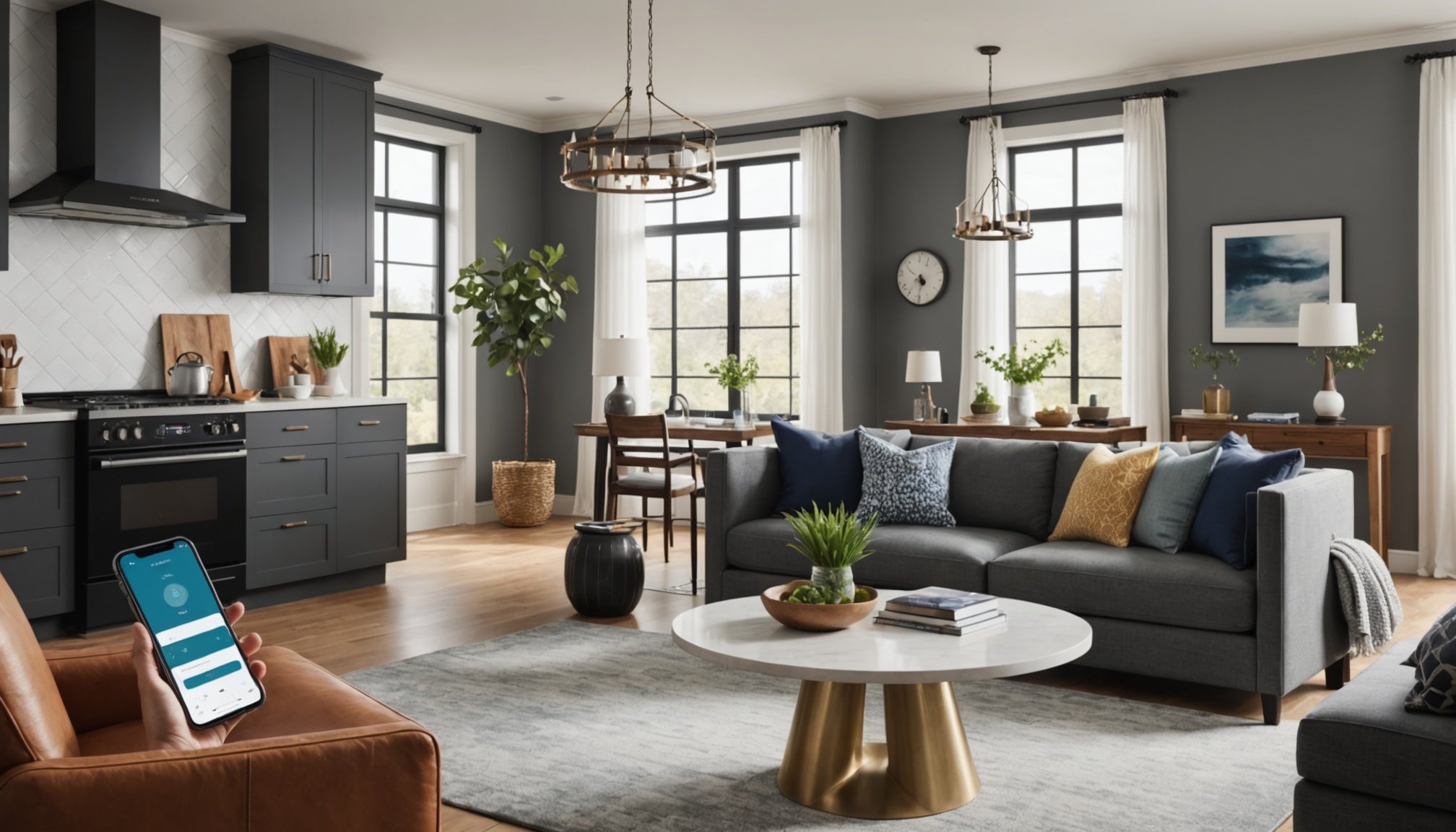Understanding Smart Living Integration
In today’s world, Smart Home Technology has revolutionized the way we interact with our living spaces, making them more adaptable and efficient. These systems offer significant benefits, such as energy savings, increased security, and enhanced convenience. By connecting various household devices and systems, smart technology enables seamless integration and control.
Central to this transformation are Voice Assistants like Alexa and Google Assistant. These virtual helpers serve as the interface between the homeowner and the smart ecosystem, offering the ability to control lighting, heating, and even entertainment systems with simple voice commands. Their importance is evident in how they facilitate hands-free management of tasks, making everyday life more manageable and less time-consuming.
Also read : Maximize your mobile efficiency: innovative tips for streamlining app organization
Moreover, Smartphone Control plays a pivotal role in the management of smart devices. With dedicated applications, users can remotely access and regulate their home environment from virtually anywhere. This allows homeowners to monitor security systems, adjust energy settings, or activate appliances, effortlessly ensuring their home operates at peak efficiency even while they are not physically present. Enjoy the convenience of adjusting your thermostat during your commute or checking security cameras from vacation – the possibilities are endless, all within reach of your smartphone.
Choosing the Right Voice Assistant
When selecting a voice assistant, it’s crucial to consider a variety of key features. The first aspect to examine is Smart Home Compatibility. This determines how well the assistant integrates with your existing array of smart home devices.
Also to see : Essential apps for streamlining multi-room smart home audio management
Some popular voice assistants include Amazon Alexa, Google Assistant, and Apple HomeKit. Each offers distinct features that cater to different user preferences. Amazon Alexa, for instance, supports a broad range of smart home products, offering seamless connectivity with numerous devices.
Google Assistant, on the other hand, excels in providing precise search information and outstanding voice recognition capabilities. It’s particularly beneficial for users deeply integrated within Google’s ecosystem.
Apple HomeKit shines with its focus on privacy and security, favouring users who prioritise these aspects in their smart home network. It is ideal for those heavily invested in Apple’s suite of products.
Key features that might influence your choice include the ease of setup, responsiveness, and integration capabilities. Consider the ecosystems you’re already using and ensure the chosen assistant complements rather than complicates them. By weighing these features and compatibility factors, you can find the perfect voice assistant tailored to your needs.
Integration Strategies for Voice Assistants and Smartphones
Integrating smart home devices with smartphones can enhance convenience and efficiency. Begin by setting up your smartphone’s voice control. Generally, this involves enabling voice assistant features in your phone’s settings and linking your smart home accounts through dedicated apps. It’s crucial for the setup to be simple to ensure everyday usability.
Automating Routines Using Voice Commands
Automation is an efficient way to manage multiple devices simultaneously. Create routines that group commands to perform specific actions, like dimming lights and setting your thermostat for movie night. Voice assistants simplify tasks by performing several actions with a single command, reducing the need for multiple interactions.
Seamless Interactions Between Voice Assistants and Smartphone Apps
Consider applications offering robust integration features. Some smartphone apps allow you to customize commands, linking various functionalities. By harmonizing voice assistants and apps, interactions become intuitive and more user-friendly, offering personalized control over your environment.
By adopting these strategies, you can unlock the potential for smart home integration, making daily chores more streamlined and enjoyable through voice control and automation. Keep exploring new tools and updates as smart technology evolves. This approach not only saves time but also leverages modern technology to its fullest potential.
Recommended Devices for Optimal Integration
Choosing the best smart devices for your home can optimize integration and functionality. When deciding, consider voice assistant compatibility as it determines how seamlessly your devices can communicate. Essential devices for an efficient setup often include smart speakers, lighting, and thermostats.
Popular options are the Amazon Echo series and Google Nest devices, which offer robust compatibility with multiple systems. These smart speakers act as central hubs, allowing voice commands to control connected gadgets effortlessly.
Smart lighting, such as the Philips Hue, allows customisation like dimming or colour changes via voice commands. Similarly, smart thermostats like the Ecobee or Nest Learning Thermostat ensure temperature control with ease, adapting intelligently to your energy use patterns.
Device recommendations should align with your lifestyle. If entertainment is your priority, consider smart TVs or streaming devices like Roku that support voice commands for hands-free enjoyment. For security, look into video doorbells and cameras compatible with your assistant.
Ultimately, select devices based on your user needs and preferences. Prioritise what will enhance your daily life, whether it’s convenience in managing tasks, security, or entertainment. Balancing compatibility and functionality will provide the most satisfying smart home experience.
Troubleshooting Common Issues in Integration
Navigating smart home troubleshooting and addressing integration challenges can be daunting for users, especially when attempting to synchronise voice assistants with smartphones. Common hurdles in this process often include connectivity issues, incompatible devices, and unresponsive gadgets.
An effective initial step in resolving these integration issues is to ensure all devices are connected to the same stable Wi-Fi network. This can eliminate numerous potential problems related to network incompatibility. Another practical solution is regularly updating both the voice assistant and smartphone software to maintain seamless communication between devices.
Problem-solving tips include resetting devices to their factory settings if issues persist. This can often clear any conflicting settings or corrupted data that might hinder operation. Users have found success by consulting online forums or support communities where peers share their experiences and proven techniques for overcoming integration hurdles.
To better understand device compatibility, verify that your voice assistant supports the specific smartphone model and the apps you intend to integrate. Checking device manuals or manufacturer websites can provide valuable insights into compatibility and additional configuration tips.
Employing a systematic approach to smart home integration fosters a smoother experience and ensures each component works harmoniously within your digital ecosystem.
Future Trends in Smart Home Technology
As we embrace an era of Smart Living Innovation, emerging technologies are reshaping the future of home automation. Key among these changes is the heightened role of artificial intelligence, particularly in enhancing voice assistant capabilities. As AI advances, we expect voice assistants to become more sophisticated, offering nuanced interaction and greater integration with a variety of smart devices. Imagine not only controlling your lighting or heating through voice commands, but also having your assistant anticipate your needs based on your daily habits.
The future of home automation promises even more interconnected devices, creating a cohesive ecosystem. Emerging technologies like 5G and edge computing will facilitate these connections, enabling faster and more reliable communication between devices. This seamless integration promises to make our living spaces more intuitive, energy-efficient, and secure.
Predictions for the future of smart living highlight the potential for smart home tech to adapt to individual preferences and environmental changes dynamically. With advancements in sensors and data analytics, smart homes could adjust energy usage based on occupancy or weather forecasts, further enhancing convenience and sustainability. In essence, the convergence of these trends not only simplifies our daily lives but also maximises efficiency and comfort in innovative ways.











